Sommaire
Lobbying and lawmaking: how to identify it? The case of the agricultural bill
The French National Assembly has begun examining a new agricultural bill, designed to respond to farmers' frustrations and secure the future of new generations in the sector. The bill includes measures on training and farm transfers, and aims to speed up legal proceedings in the event of challenges to agricultural projects, despite some concerns expressed by the Conseil d'État about the constitutionality of these measures.

And we are witnessing an extremely substantial pile-up, with 4,537 amendments. This figure, which is already more than substantial, is illustrated by another figure in particular: 35.5% of the amendments are just duplicates and come from agricultural lobbies. This is an opportunity to see how lobbying is dispersed in this jumble.
The summary
- Lobbying is understood by all political groups. And for a simple reason, sometimes a lot of the demands made are matters of common sense, irrespective of political divide or vision. So to see people in the sector distinguish between advocacy and lobbying is sheer hypocrisy. The fact is that there are few lobbies that don't attract at least one MP from one camp.
- It is understandable that Members should adopt an extremely technical amendment. But it is incomprehensible that Members, in order to explain why they are proposing the measure, should copy word for word the lobbies' explanatory memoranda. The figure for amendments which admit that the amendment comes from a lobby is also only 35%. With a big disparity. In this game, LR, which is the most prolific party in publishing amendments from lobbies on the Farm Bill, is also the one that indicates the least where they come from. And by a long way.
- Lobbies that are highly entrenched, active and otherwise have a huge advantage when it comes to legislation such as this. The hardest part is not tabling amendments and getting them voted through, but getting the law included in the parliamentary shuttle. In this game, the FNSEA was ready and deployed an imposing lobbying effort, albeit a very identifiable one insofar as its lobbying relies on 8 to 10 main MPs in addition to regional lobbying, with the RN in particular as a target.
- When you have more than 4,000 amendments to a law, which is extremely prolific, it becomes increasingly illusory to process this data manually, especially when a third of the amendments are duplicates.
Documenting and identifying lobbies and their positions
Needless to say, I'm well-equipped to start the search with Follaw by simply and stupidly typing (stronger queries could be made) "agricultural sovereignty" and sorting them by tweet position. ( It's also possible to see their relationship with the HAVTP)
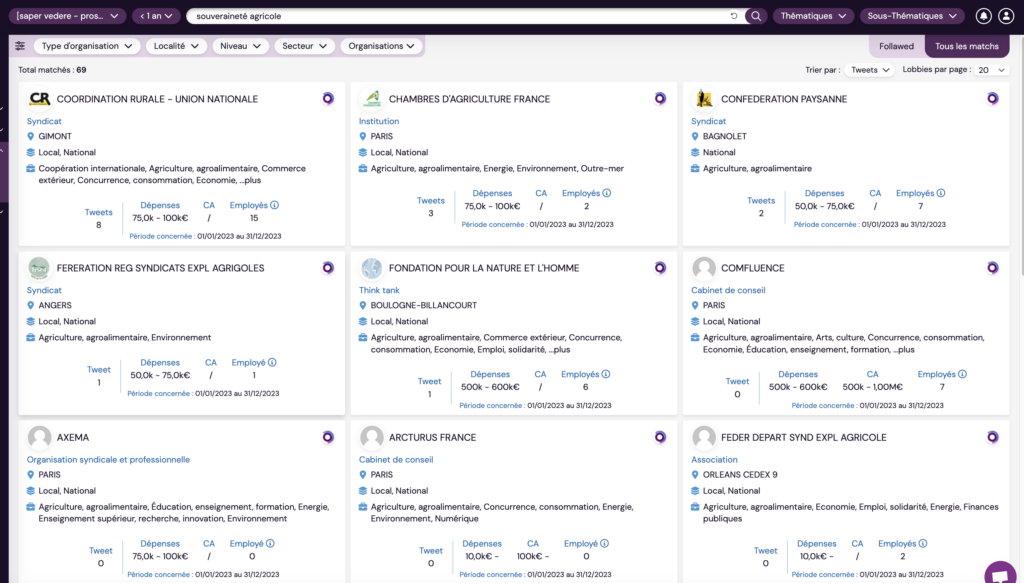
News will be useful for isolating agendas, appointments, paper positions and so on.
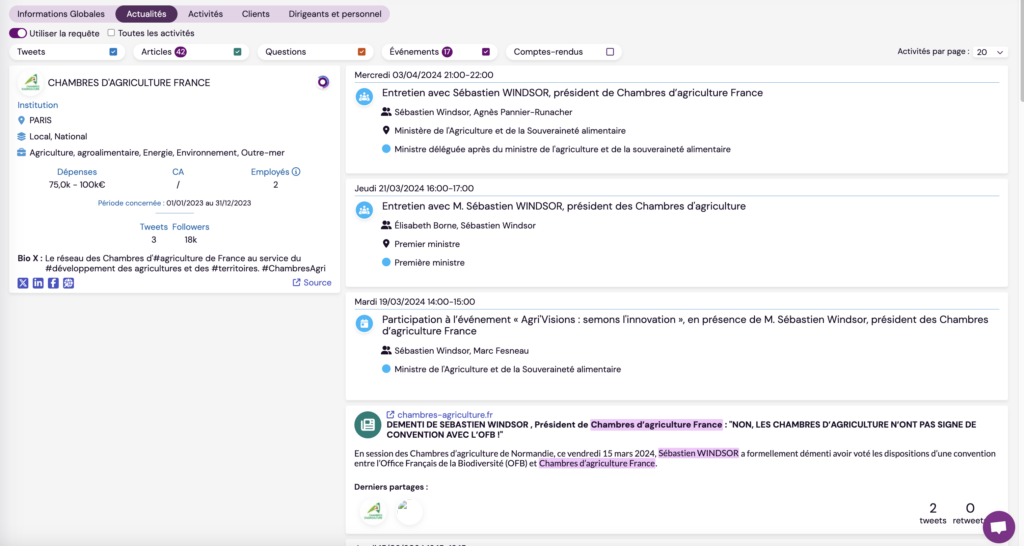
This will help us to understand how they can position themselves and how they can fight back. Of course, Google, its PDFs and so on are going to be very useful. But, paradoxically, so will LinkedIn!
Identify similar amendments
Identify whether the amendments focus on a particular group
In this case, it's a fairground for amendments and lobbying. We are going to see turnkey amendments. In their lobbying, a certain number of interest groups will throw themselves wholeheartedly into giving Members turnkey amendments. A majority of them will be content to reproduce the explanatory memorandum provided in addition to the operative part.
In the context of the agricultural project, one obvious assumption is that all the parties want to satisfy farmers. What we are seeing is a coalition of parties unlike anything seen elsewhere, where the left, the right, the centre and the extremes are tabling the same amendments in concert. That said, these are mostly isolated cases (as usual), as the alliance of similar amendments seems to be focused on an alliance between LR and Renaissance. LR also has amendments from lobbies similar to Ecolo, which has amendments similar to the Socialists. In short, the lobbies are quite disparate. In this case, analysis is therefore pointless. Lobbying is widespread.
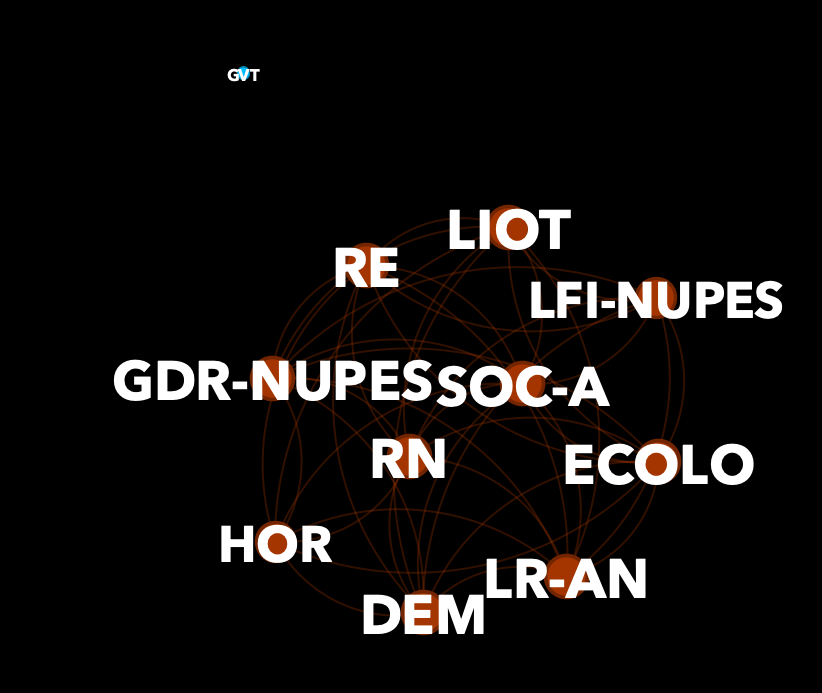
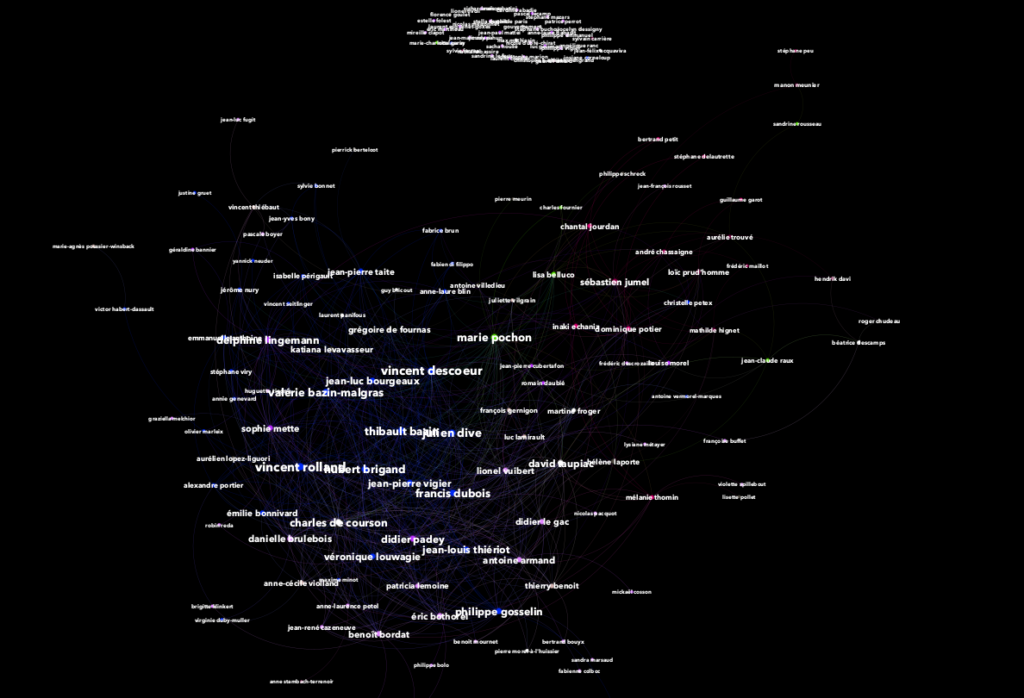
Link similar amendments and guess
As this stage can save time, we need to deploy a broader method. In addition to this methodology of mapping co-amendments, at Saper Vedere we have a tool that automatically points out similar amendments and groups them together for analysis. So I carried out a complete analysis to see where the lobbies' influences came from. Analysing similar amendments makes the task a little easier, but we're talking about no less than 240 similar amendments here . A big job ahead. Let me summarise the main principles:
The lobby is announced by the MP himself
In the explanatory statement, the MP clearly states that the amendment comes from a specific place. In this case, the FNSEA 27 (L'Eure) is going to use several MPs from different groups (Ici LIOT, RE, LR, and RN), all of whom are going to ape or nearly ape the amendment right up to the explanatory statement.

And only the RN MP will mention this explicitly, unlike all the others.
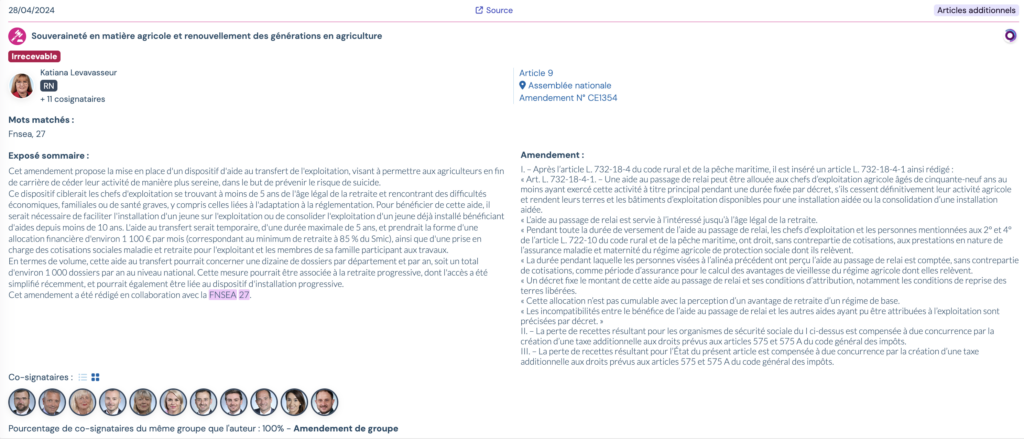
The position paper is the law: Linkedin and the press as the main sources
We were able to identify a relatively clear amendment by the FNSEA and the Young Farmers:
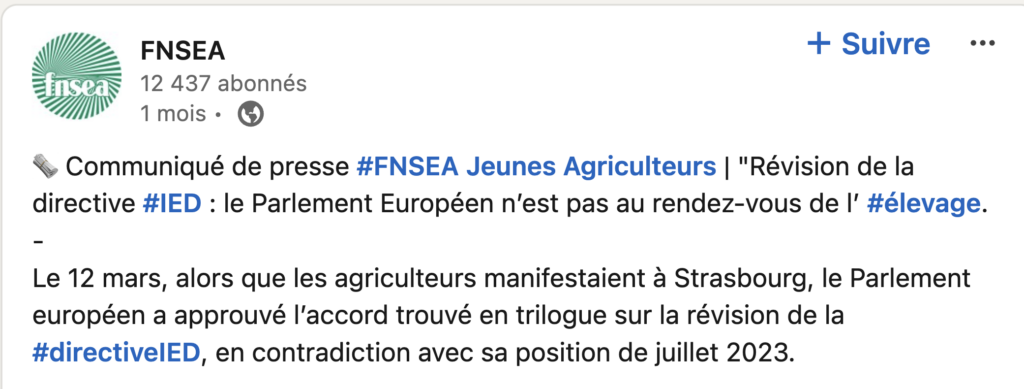
But also in the articles, we quickly isolate provisions that are very likely to be found in the amendments:

The fact is that lobbying can never be confined to individual meetings. It must also be accompanied by communication measures to exert pressure and create a point of tension in public opinion. It is therefore easy to make the correlation between similar amendments in different groups and lobbying action.
Identifying alliances
Sometimes, funnily enough, we come across similar amendments, but where Members (in all transparency) indicate the sources of similar amendments. This makes it possible to identify alliances. This is the case of amendments worked on with the Nourrir collective and the Confédération paysanne. There's nothing surprising here, but this shows another example of how amendments are used.
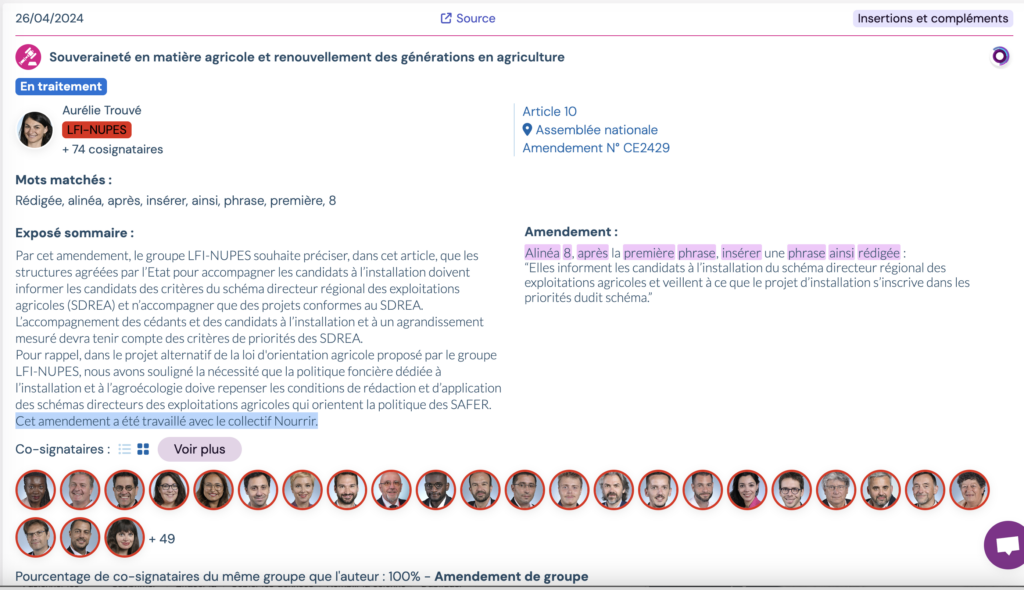
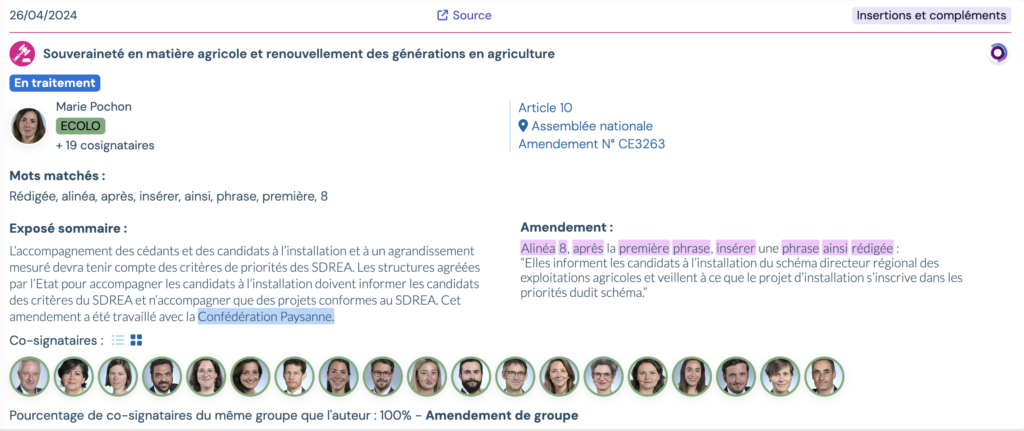
We identify the champions of the lobbies to guess those who remain
If you want to see how a lobby is doing, just type its name into Follaw and you will automatically see the amendments that mention collaboration.
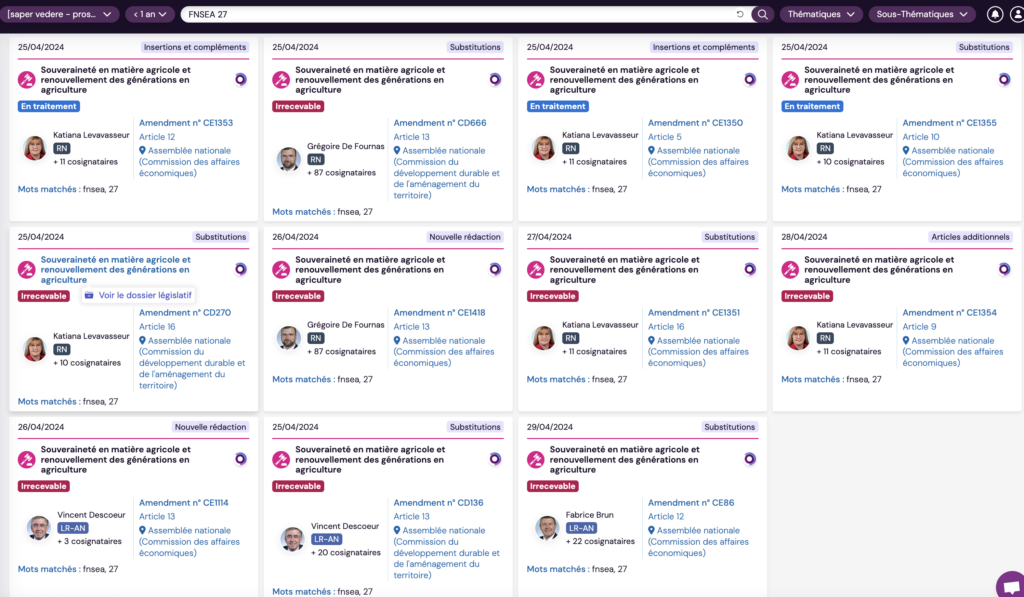
For the Nourrir collective, there are no fewer than 10 pages of amendments available, with a wealth of alliances and "turnkey" MPs who also have the distinction of being LFI and Renaissance!
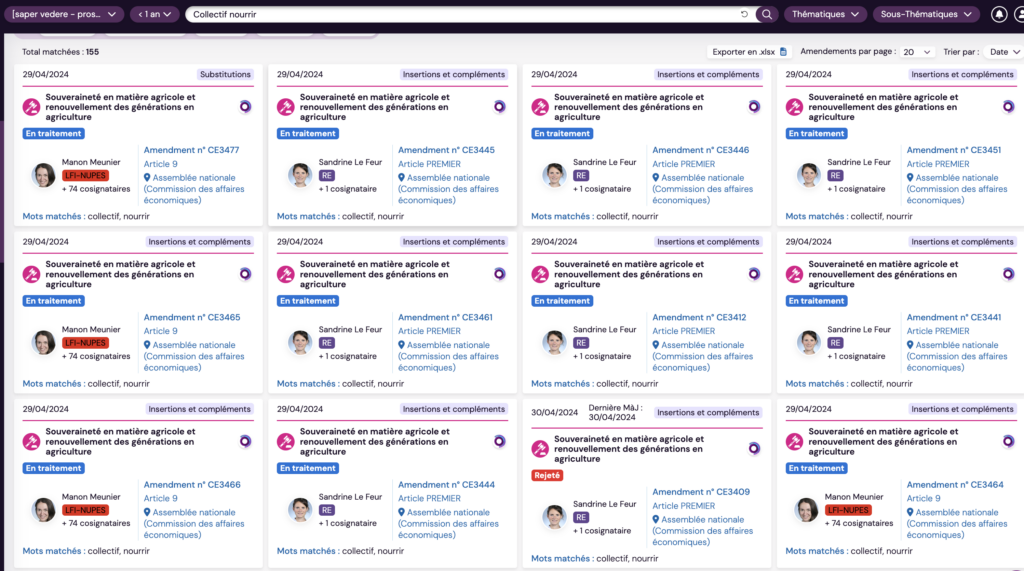
And it's easy to identify the likelihood of an amendment coming from this or that lobby by looking at the documentation, past data and MPs' commitments! All this makes analysis much easier. Enough theory, let's get on with the analysis!
We're ready to go! It's time to play with the data
If you look at the number of amendments tabled by MPs in their name, you can see the butchery carried out by the FNSEA. They were impatiently awaiting the law, and now it's here. And so everything is included. The CNEAP (Conseil National de l'Enseignement Agricole Privé - National Council for Private Agricultural Education), which has decided to take advantage of the situation to push its own education agenda with a whole series of amendments, should also be noted. The FNSEA is in full force. The FNSEA's tactics are relatively easy to identify:
- The departmental federations are going to hit up the local MPs. In particular, they are responsible for bringing together RN MPs.
- Young farmers make it possible to win votes a little further to the left.
- The Chamber of Agriculture attracts the centrists and the government.
On the other side (the agroecology or organic sector), they are organising themselves into alliances and moving forward in a scattered order. This is easily seen in the amendments, which are the same but claimed by others.
As far as the parties are concerned, it's good to be in the company of LR, which is the author of almost 47.3% of the turnkey amendments based on the 100 treaties. (out of 240) Note that some lobbies may not be included in this list. This is the case of the national federation Afac-Agroforesteries, which has been particularly active in the latest amendments.
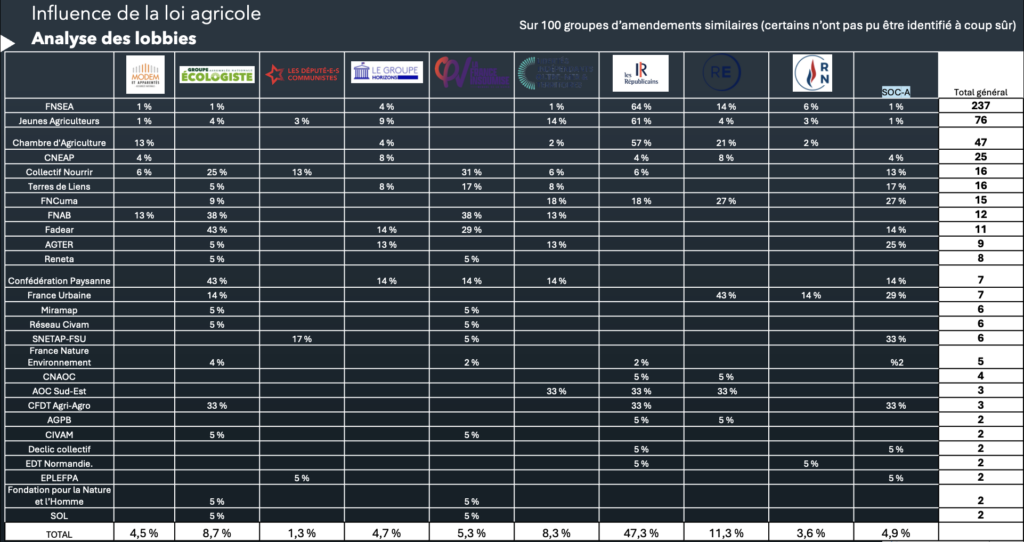
This tectonic shift has effectively created two major groupings: the more left-wing, organic and peasant coalition and the group of MPs captured by the FNSEA and young farmers.

By mapping the parties, it's even clearer!

Note that if you are a Follaw customer, you can easily identify the amendments via the "amendments & lobbies" query available in the 700 ready-to-use queries!
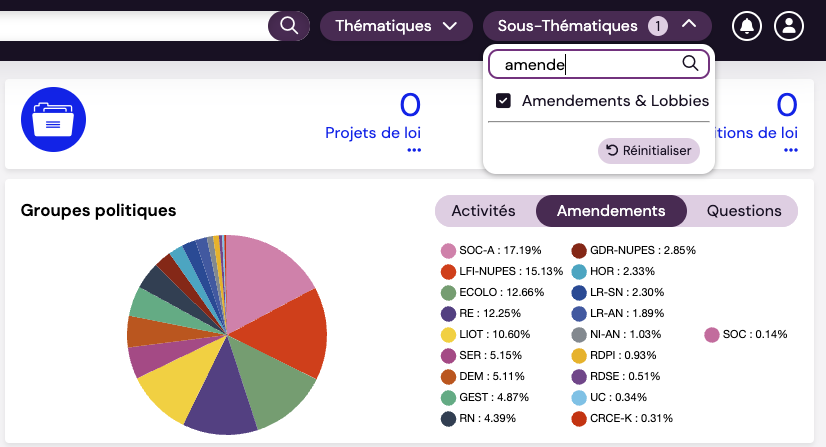
And it's easy to see that most of the parties are transparent about lobby amendments. All except? LR. The party that produces 47% of the amendments from lobbies in our sample.
The good students who clearly announce where lobbies come from are: (with a LR / Do not pay attention to the number of tweets because it is normal that the formulas of collaboration with a lobby are not expressed on X)
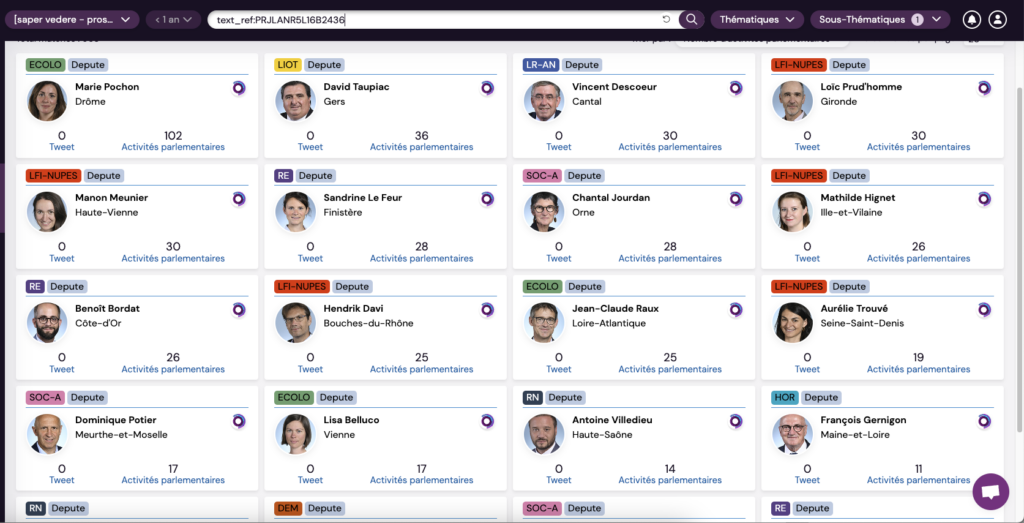
Ultimately, it's all about transparency and data!



